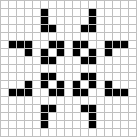Complexity and Emergence
by Krešo Josić
Today, let's talks about emergence. The University of Houston's Mathematics Department presents this program about the machines that make our civilization run, and the peoplewhose ingenuity created them.
Ant colonies are truly fascinating. I am sure you have marveled at what a colony of ants can do: They build complex structures, and roads. They work together to bring down large prey. They have a complex society with well-defined roles. The famous biologist E.O. Wilson says that an ant colony is more than a collection of individual insects. It is a single superorganism.
While each individual ant is a marvel of evolution, it is also a relatively simple creature. Your brain has roughly a million times more neurons than the brain of an ant. The actions of a single ant are much simpler than those of the colony. The complex behavior of the colony emerges from the interaction of thousands of simple beings.

But how is this possible? How can agents that obey simple rules create a colony whose behavior seems infinitely more complex? These are the questions that lead to the notion of emergence — a multitude of simple rules can combine into far more complicated structures.
We can construct mathematical examples of emergent behavior. Consider the surprisingly simple, yet complex "Game of Life". Here are the rules described in the 60's by Princeton mathematician John Conway: The game is played on an infinite chess board. Each square can be occupied by a cell. If a cell has only one neighbor or no neighbors, it dies of loneliness. A cell with four neighbors dies from overcrowding. So that's death, but what about life? A cell with two or three neighbors lives to another day. Three cells surrounding an empty square, will reproduce and introduce a new one into the empty space.
Now put some cells on the chessboard in some pattern. Lonely cells will perish, and triplets of cells will reproduce. With time your initial pattern will shift and change.

And this is where the amazing thing happens. These simple rules can lead to an infinite variety of patterns. Some look like blinking pulsars. Others appear as spaceships that embark on endless voyages. Breeders and guns shoot off patterns to infinity. This complex behavior is emergent – it is a result of the interaction of very simple rules applied over and over.
Scientists often try to understand nature by trying to break things down into simple parts. This approach may have its shortcomings. Sometimes we have to ask how simple pieces come together to form a more complex entity.

If we look at the world around us, we see emergence everywhere. The individual pieces of your car are far simpler than the vehicle that is the result of their interactions. Your computer performs millions of incredibly simple operations that weaved together allow you to browse the web. There is nothing mysterious here — these machines can be understood by examining how their parts interact. Will we be able to some day understand our own minds in the same way? Perhaps so. But perhaps there are some things that are far greater than the sum of their parts. And we may need to develop completely new ways of thinking to comprehend them.
This is Krešo Josić at the University of Houston, where we are interested in the way inventive minds work.
You can read a short review of Bert Hölldoblerr and E.O. Wilsons' book here https://www.wired.com/culture/culturereviews/magazine/16-11/pl_print and here https://www.nytimes.com/2008/11/23/books/review/Jones-t.html.
There are many excellent scientists working on collective animal behavior. Our local experts on ants are Blaine Cole and Diane Wiernasz http://www.nsm.uh.edu/~bcole/.
There are many websites devoted to the Game of Life. Here is an incredible example of a "spaceship gun". Notice how the "gun" seems to assemble spaceships and then shoots them off https://vimeo.com/5428232. The Wikipedia entry on the Game of Life has links to a number of online sites that allow you to "play" the game.
It is interesting to note that anything computable with a Turing machine is computable within the Game of Life. Therefore, the game can be used to compute anything that can be computed algorithmically.
Images:
- https://en.wikipedia.org/wiki/File:Game_of_life_pulsar.gif
- https://en.wikipedia.org/wiki/File:Gospers_glider_gun.gif